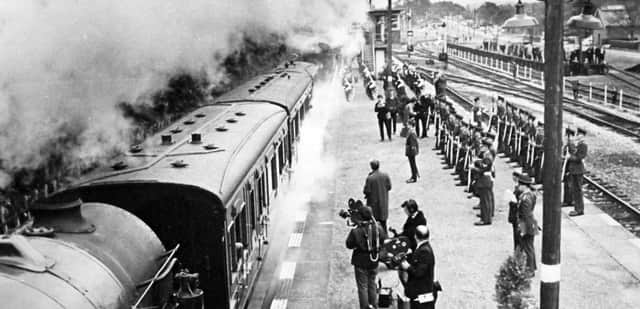MoD railway which starred in St Trinian's and Young Winston


It was begun in 1903 by Royal Engineers to train soldiers how to build railways and then operate them. It was known as the LMR – Longmoor Military Railway.
The distance from Liss to Bordon is only eight miles, but the track distance of the whole system ran for 71 miles including the four-mile Hollywater loop.
Woolier Yard contained 53 sidings of various lengths.
At one time, the railway owned 27 different locomotives.
In June 1941 3,000 passengers used the line.
Advertisement
Hide AdAdvertisement
Hide AdThe railway not only trained its engineers in the operating side, but it also trained men in mine warfare, demolition, re-railing and more furtively, how to blow up a railway line.
They had their own signal school which consisted of an electrically-controlled O-gauge railway together with full size block instruments, just like a signal box on the main line.
No doubt you might have seen the film The Great St Trinian’s Train Robbery.
It was filmed at the railway in 1965 and several other movies, including Young Winston’ in 1972 and The Lady Vanishes in 1938, were also filmed on the line.
Advertisement
Hide AdAdvertisement
Hide AdIn the late 1960s the Ministry of Defence decided to close the railway and a final public open day was held on Saturday, July 5, 1969.
These open days were well attended, not only by railway enthusiasts who held the system in great esteem, but also for those who enjoyed the many activities and displays put on at the camp as well.
On the last open day an estimated 12,500 people attended and 17,500 train rides were booked.
Also on the final day, the longest train ever to run on the line, a 14-coach Bulleid Society excursion, arrived at Liss.
A locomotive called General Gordon acted as a pilot engine.
Advertisement
Hide AdAdvertisement
Hide AdIt was attached in the station and then hauled the train on to the Longmoor branch system.
Another event on the final day was a helicopter rescue in which a wagon was deliberately derailed so that spectators could see how the wagon could be put back on the rails.
A cricket match was also played at Longmoor cricket ground between the Royal Corp of Transport and a team called The Dragonflies.
After the last open day and what appears to have been a marvellous exhibition for all concerned, the railway was run down and finally closed on the following October 31.
Trains still ran until 1970 removing rolling stock.
There were dozens of coaches and hundreds of goods wagons.
Advertisement
Hide AdAdvertisement
Hide AdDemolition men then used the trains to pick up the rails behind the train as they were lifted. By the end of 1972 very little remained.
A preservation group, led by artist David Shepherd, who specialises in painting steam locomotives and wildlife – particularly elephants, took over the sidings at Liss station and placed many locomotives there including the famous Merchant Navy class Clan Line.
His hopes of purchasing part of the line were dashed when local residents, very much against having a preservation railway running alongside their properties, purchased part of the track before the group had raised funds. This put an end to their aspirations and the stock was sent to the East Somerset Railway.
n Can you remember when much of Portsmouth was shaded by massive elm trees?
Advertisement
Hide AdAdvertisement
Hide AdIn October 1971, the council was informed that Dutch Elm Disease had taken hold in the city.
Four hundred and fifty elms were affected and £10,000 was set aside for the felling and replacement of the trees.